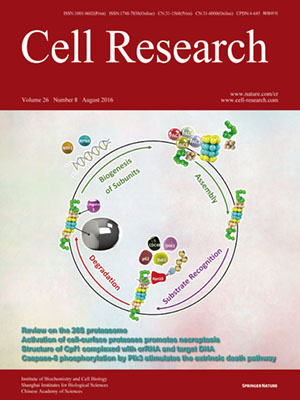
Volume 26, No 8, Aug 2016
ISSN: 1001-0602
EISSN: 1748-7838 2018
impact factor 17.848*
(Clarivate Analytics, 2019)
Volume 26 Issue 8, August 2016: 914-934 | Open Access
ORIGINAL ARTICLES
Ligand stimulation of CD95 induces activation of Plk3 followed by phosphorylation of caspase-8
Christina Helmke1, Monika Raab1, Franz Rödel2,3, Yves Matthess1,3, Thomas Oellerich3,4, Ranadip Mandal1,3, Mourad Sanhaji1, Henning Urlaub5,6, Claus Rödel2,3, Sven Becker1 and Klaus Strebhardt1,3
1Department of Gynecology, Goethe University, 60590 Frankfurt, Germany
2Department of Radiotherapy and Oncology, Goethe University, 60590 Frankfurt, Germany
3German Cancer Consortium (DKTK)/German Cancer Research Center, 69120 Heidelberg, Germany
4Department of Medicine II, Hematology/Oncology, Goethe University, Theodor-Stern-Kai 7, 60590 Frankfurt, Germany
5Bioanalytical Mass Spectrometry Group, Max Planck Institute for Biophysical Chemistry, Am Fassberg 11, 37077 Göttingen, Germany
6Bioanalytics, Institute for Clinical Chemistry, University Medical Center Göttingen, Robert-Koch-Straße 40, 37075 Göttingen, Germany
Correspondence: Klaus Strebhardt, Tel: +49-69-6301 6894; Fax: +49-69-6301 6364(strebhardt@em.uni-frankfurt.de)
Upon interaction of the CD95 receptor with its ligand, sequential association of the adaptor molecule FADD (MORT1), pro-forms of caspases-8/10, and the caspase-8/10 regulator c-FLIP leads to the formation of a death-inducing signaling complex. Here, we identify polo-like kinase (Plk) 3 as a new interaction partner of the death receptor CD95. The enzymatic activity of Plk3 increases following interaction of the CD95 receptor with its ligand. Knockout (KO) or knockdown of caspase-8, CD95 or FADD prevents activation of Plk3 upon CD95 stimulation, suggesting a requirement of a functional DISC for Plk3 activation. Furthermore, we identify caspase-8 as a new substrate for Plk3. Phosphorylation occurs on T273 and results in stimulation of caspase-8 proapoptotic function. Stimulation of CD95 in cells expressing a non-phosphorylatable caspase-8-T273A mutant in a rescue experiment or in Plk3-KO cells generated by CRISPR/Cas9 reduces the processing of caspase-8 prominently. Low T273 phosphorylation correlates significantly with low Plk3 expression in a cohort of 95 anal tumor patients. Our data suggest a novel mechanism of kinase activation within the Plk family and propose a new model for the stimulation of the extrinsic death pathway in tumors with high Plk3 expression.
10.1038/cr.2016.78
FULL TEXT | PDF
Browse 1909


